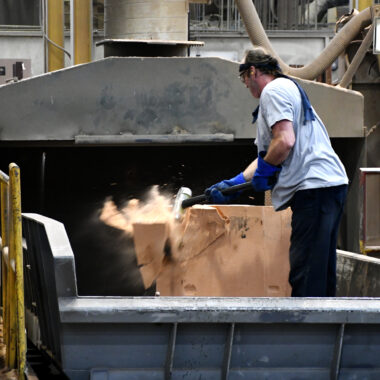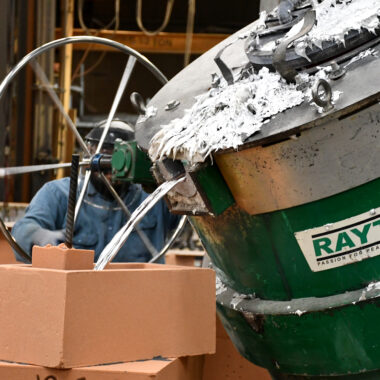Innovation Let Loose: Progressing Casting Aluminum Illinois
Innovation Let Loose: Progressing Casting Aluminum Illinois
Blog Article
Accuracy and Perfection: Ideal Practices for Successful Light Weight Aluminum Casting
In the world of light weight aluminum spreading, achieving accuracy and excellence is not simply an objective yet a requirement that distinguishes quality. The meticulous procedure of aluminum casting demands attention to information at every phase, from material choice to final finishing touches.
Product Option
When considering product option for aluminum casting procedures, longevity, and heat resistance are vital variables to review. Light weight aluminum alloys offer a large variety of choices, each with one-of-a-kind homes that can significantly affect the quality and performance of the last casted item. One common choice is the 356 alloy, understood for its excellent fluidness and resistance to rust, making it suitable for a range of applications. For high-stress environments needing remarkable stamina, the 7075 alloy stands apart due to its high strength-to-weight proportion. Furthermore, the 6061 alloy is preferred for its good weldability and formability, making it a versatile alternative for complex layouts.
In the selection procedure, it is essential to take into consideration not only the mechanical properties of the alloy yet also its thermal characteristics. Heat resistance is vital to make sure that the casted component can stand up to the temperatures it will certainly be revealed to throughout procedure without jeopardizing its architectural honesty. By very carefully evaluating the toughness and warmth resistance of various light weight aluminum alloys, makers can make educated choices that result in high-quality, trustworthy casted items.
Mold Style
In the world of light weight aluminum spreading finest methods, an indispensable aspect that dramatically affects the end product's quality and integrity is the thorough layout of the mold. Mold design plays a crucial role in determining the dimensional precision, surface coating, and general ins and out of the cast aluminum part. When creating a mold and mildew for light weight aluminum spreading, several crucial variables must be taken into consideration to guarantee optimum outcomes.
To start with, the mold layout need to represent the product circulation features of liquified light weight aluminum to protect against defects such as shrinkage, porosity, or misruns. Appropriate gating and riser positioning are vital elements in the mold and mildew style process to assist in smooth steel circulation and reduce the formation of air pockets.
In addition, the mold and mildew design should think about the cooling price of the light weight aluminum to avoid fracturing or distortion throughout solidification. Adequate airing vent and cooling down channels within the mold can help control the temperature circulation and promote uniform solidification of the steel.
Process Optimization
To boost effectiveness and top quality in aluminum casting, procedure optimization plays an essential duty in optimizing and streamlining operations output. By fine-tuning each step of the casting process, producers can determine traffic jams, reduce waste, and boost general performance. One essential facet of procedure optimization is the assimilation of innovative technologies, such as computer simulations and anticipating modeling, to evaluate and enhance casting parameters. These tools enable online testing of different situations, leading to enhanced casting layouts and reduced trial-and-error on the production line.
Additionally, implementing lean manufacturing principles can even more boost process optimization in aluminum casting. By removing non-value-added activities and concentrating on continual renovation, suppliers can accomplish higher performance levels and much better resource use. In addition, routine surveillance and analysis of vital efficiency indications (KPIs) assist in identifying areas for enhancement and making data-driven choices to enhance the spreading procedure continually.
Quality Control
Refine optimization in light weight aluminum spreading not just improves effectiveness and productivity yet also lays the structure for stringent quality assurance actions to support sector criteria. Quality control is paramount in making sure that last aluminum spreadings fulfill the called for requirements and performance requirements. Carrying out a detailed top quality control procedure involves numerous steps, beginning with the first layout stage through to the last examination of the cast components.

Additionally, establishing clear top quality control protocols and paperwork procedures is essential for monitoring and monitoring the casting procedure. By preserving thorough records of manufacturing criteria, screening outcomes, and inspection reports, makers can make certain uniformity and traceability in their light weight aluminum casting operations. Adhering to rigorous quality assurance methods not only improves the overall dependability of aluminum spreadings yet also imparts self-confidence in clients relating to the high quality of the end products.
Ending Up Techniques
Exactly how can aluminum casting be enhanced with careful application of finishing strategies? Completing techniques play an important role in elevating the top quality and aesthetics of light weight aluminum castings.

Additionally, methods like powder covering or paint can be applied to light weight aluminum castings to provide both aesthetic allure and additional defense against environmental variables. By very carefully click here to find out more choosing and using the ideal completing methods, makers can make certain that their light weight aluminum spreadings satisfy the highest criteria of high quality and efficiency.
Final Thought
To conclude, effective light weight aluminum spreading requires accuracy and excellence in material option, mold and mildew layout, procedure optimization, quality assurance, and finishing techniques. By adhering to finest methods in each of these areas, suppliers can guarantee high-grade and consistent lead to their light weight aluminum casting procedures. casting aluminum illinois. It is important to take notice of every detail and constantly make every effort for renovation to achieve optimal end results in aluminum spreading
The thorough process of light weight aluminum spreading demands interest to detail at every phase, from material selection to final completing touches.To improve effectiveness and quality in light weight aluminum casting, process optimization plays a critical duty in taking full advantage of and enhancing procedures result.Refine optimization in light weight aluminum spreading not only improves efficiency and productivity yet also lays the foundation for rigorous top quality control procedures to maintain industry standards.One important facet of quality control in light weight aluminum casting is the use of sophisticated testing techniques to examine the stability and buildings of the spreadings.In conclusion, successful light weight aluminum casting calls for precision and perfection in product choice, mold and mildew layout, procedure optimization, quality control, and completing techniques.
Report this page